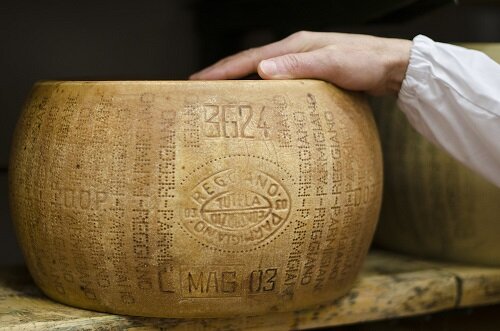Everything You Wanted to Know about Parmigiano Reggiano Rinds
Parmigiano Reggiano whole
Any home cook worth their salt has a wedge of really good Parmigiano Reggiano tucked away in their cheese drawer. But what happens when you’re done grating the last bit of cheese onto your spaghetti pomodoro? Toss the nubby rind in the compost?
No way! There’s loads of umami-rich flavor left to be savored; so if you don’t already do so, it’s time to start upcycling your Parmigiano Reggiano rinds! Here’s what you need to know so you never waste any precious Parm again.
What is Parmigiano Reggiano?
Parmigiano Reggiano aging
Parmigiano Reggiano is a raw cow’s milk cheese produced in the Italian provinces of Parma, Reggio Emilia, Modena, and parts of Mantua and Bologna. Just 3 ingredients go into making Parmigiano Reggiano: milk, salt, and rennet. It also takes time. For the cheese to achieve its signature blond color and granular texture; Parmigiano Reggiano wheels age for a minimum of 12 months, and up to 36+ months.
How is the rind formed?
According to Italian specialty cheese consortium Agriform AOP, the rind itself is formed in the early stages of production, when the just-made wheels of cheese are placed in a salted brine for about 20 days. Through the process of osmosis, water from within the cheese is expelled and salt from the brine is absorbed. At this point, the cheese begins to form a natural rind. The process continues during the aging process as the cheese slowly releases moisture and the rind hardens.
What do the numbers mean on the rinds?
The intricate and unique labeling found on Parmigiano Reggiano rinds serve as marks of origin for the cheese. Each wheel is assigned a casein plaque that has a unique number, the Parmigiano Reggiano PDO identity card. Marks are applied to the rind using a special branding mold, which incises each wheel with the month and year of production and the registration number of the cheese house where it was made.
Cooking with Rinds
Pamigiano Reggiano chunks
Chef Sara Jenkins, author of Olives and Oranges: Recipes and Flavor Secrets from Italy, Spain, Cyprus, and Beyond” and co-author of The Four Seasons of Pasta, likes to use the rinds to flavor her simmering stocks and ragus. She also cuts up the rinds and fries them or roasts them in the oven until they’re puffed up and crispy. “I use them as a crouton more than anything. The rinds add richness and flavor,” says Jenkins.
Simone Ficarelli of the Consorzio del Formaggio Parmigiano Reggiano likes fried and crispy rinds as well, but he also has several other recommendations:
Try boiling the rinds for several hours in hot vegetable or meat broth, then chopping them into small pieces, and tossing them into your favorite vegetable soup.
Spear cubes of the cooled, boiled rind onto skewers (spiedini) along with meat or vegetables to bake or grill.
The rinds can also enrich a risotto. Plop the rinds in the risotto after it's halfway done cooking, says Ficarelli, let everything simmer as you stir and add more broth, then remove the rinds just before serving.
Preparing and storing the rinds
Use a brush and some water to scrub the rinds clean, then dry, and store in an airtight container or plastic wrap in the refrigerator until ready to use.



